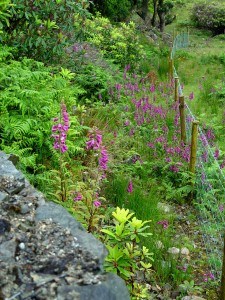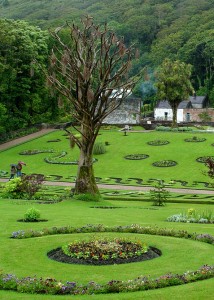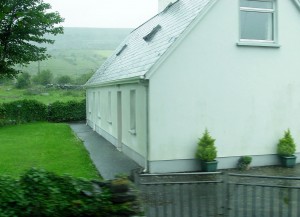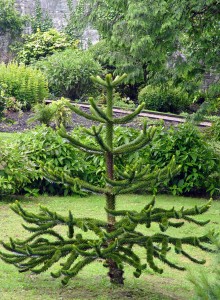Where Gardening’s Easy
June 28th, 2011
I’m just back from leading a Harrigan Holidays garden tour to Ireland, the land where foxgloves grow wild in roadside ditches and Japanese beetles don’t exist.
Things are SO much easier on gardeners there.
The soil’s good, the rain plentiful, the problems few, and the temperatures hover mainly in the 40-to-70-degree range all year.
That allows the Irish to grow plants that we lose on both ends.
Their lobelia, primrose and pansies, for example, don’t flame out like ours do in 100-degree summers. They can even grow the prized blue poppy (Meconopsis) that we can’t even baby through one of our heat waves.
On the other hand, the Irish can grow palms, fuchsia and monkey puzzle trees (a Dr. Seuss-like conifer) that freeze out in our winters.
Climate change is having a noticeable impact, though.
Like us, the Irish have been getting more extreme weather.
Last year, it was a rare drought. This spring, much of the island got hammered by 80-mph winds that toppled trees, scorched the edges of many tree leaves and blew all of the leaves off of others.
Even worse was the past two Irish winters — some of the coldest in a century.
Winter lows bottomed out at zero this past winter, which as unheard of. That froze back a lot of usually winter-hardy landscape shrubs and killer others.
The damage is still evident as gardeners there wait to see whether their laurels, aucubas and English hollies bounce back.
The saddest example we saw was inside the walled garden at Kylemore Abbey near Galway on the West coast. A 25-foot dead skeleton of a tree now stands as the central feature of a large ornamental bed there.
It turns out this tree was a cordyline — the biggest, oldest of its kind in all of Ireland.
Cordyline is the same plant we use as 2-foot-tall spiky pot centerpieces — similar to dracaena spikes. That cordyline had survived more than a century’s worth of winters, but not this past one.
Anja Gohlke, Kylemore’s head gardener, said the only hope is that this old cordyline will push enough new shoots to justify patience.
But she says a bigger question is how much Kylemore and Irish gardeners in general will need to rethink what’s reliably hardy if this climate pattern continues.
One other thing that struck me about Irish landscapes is how most homes have paving (concrete, asphalt or manufactured pavers) right up to their homes.
We tend to line our foundations with 3- to 4-foot foundation beds and run our walks along those.
Paving along the house looks more barren (at least without gardens along the walks), but it makes practical sense for several reasons.
A big one is avoiding the artillery-fungus problem that results when this mulch-borne fungus shoots its sticky black “dots” (technically, “gleba”) onto siding.
It also lessens termite and ant infestations without wood mulch right against the wall, and it solves the issue of plants not getting rain due to roof overhangs.
I still haven’t fully figured out why Ireland doesn’t have more pest bugs and plant diseases.
The isolation of being an island nation helps, but if ash borers and Japanese beetles found their way to America, you’d think a few would’ve hitched a ride to Ireland by now.
The cooler summers might have something to do with the surprisingly low rate of disease for such as wet country. It seems to shower every 10 minutes in Ireland — at least when I’m there and outside.
None of the Irish gardeners I talked to could give me any better explanations on why their rhododendrons don’t get the Phytopthora root-rot that plagues ours, why they can get away without spraying apple trees, and why slugs don’t shred their hostas.
There are so few bugs in Ireland that the Irish don’t even bother to use window screens.
Maybe it’s the famed luck of the Irish spilling over into gardening.
Or maybe it’s the fairies that come out at night to keep watch over the plants.
Whatever it is, my gardens could use a wee bit of it.











